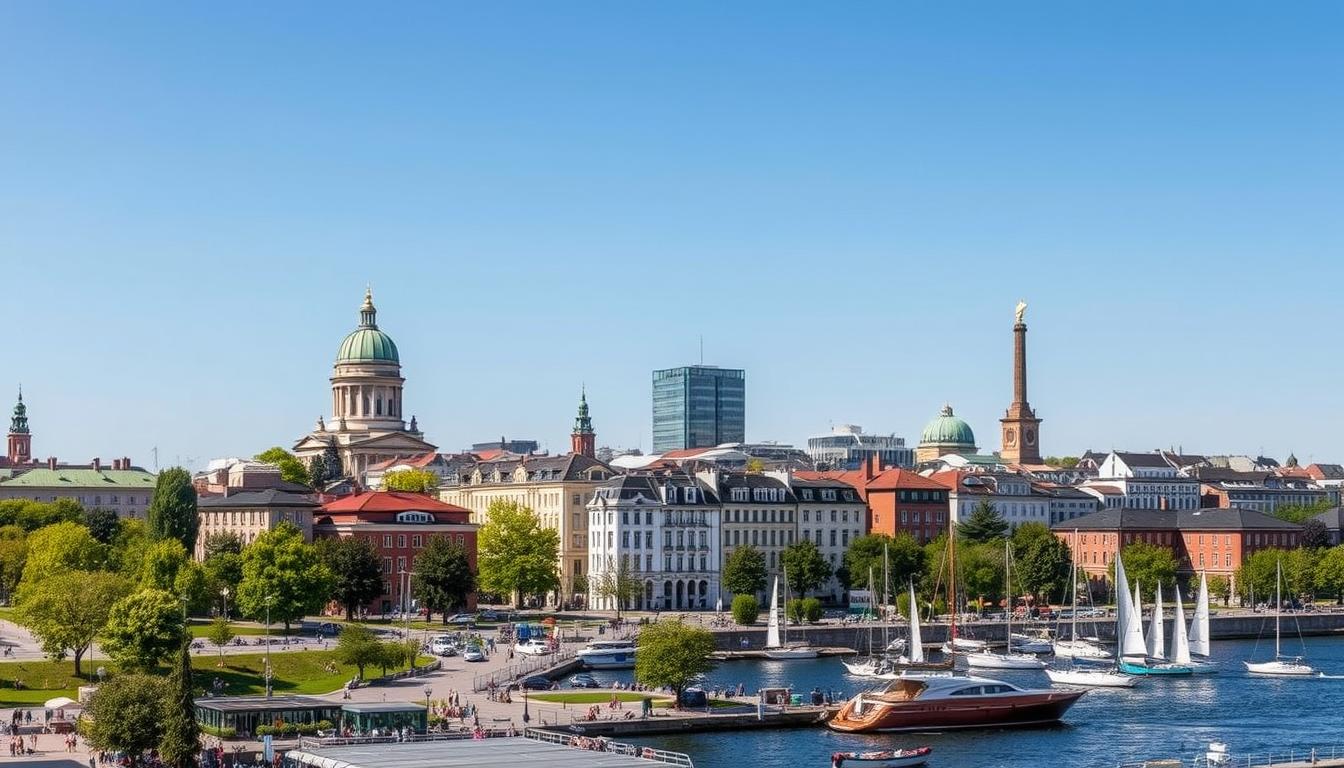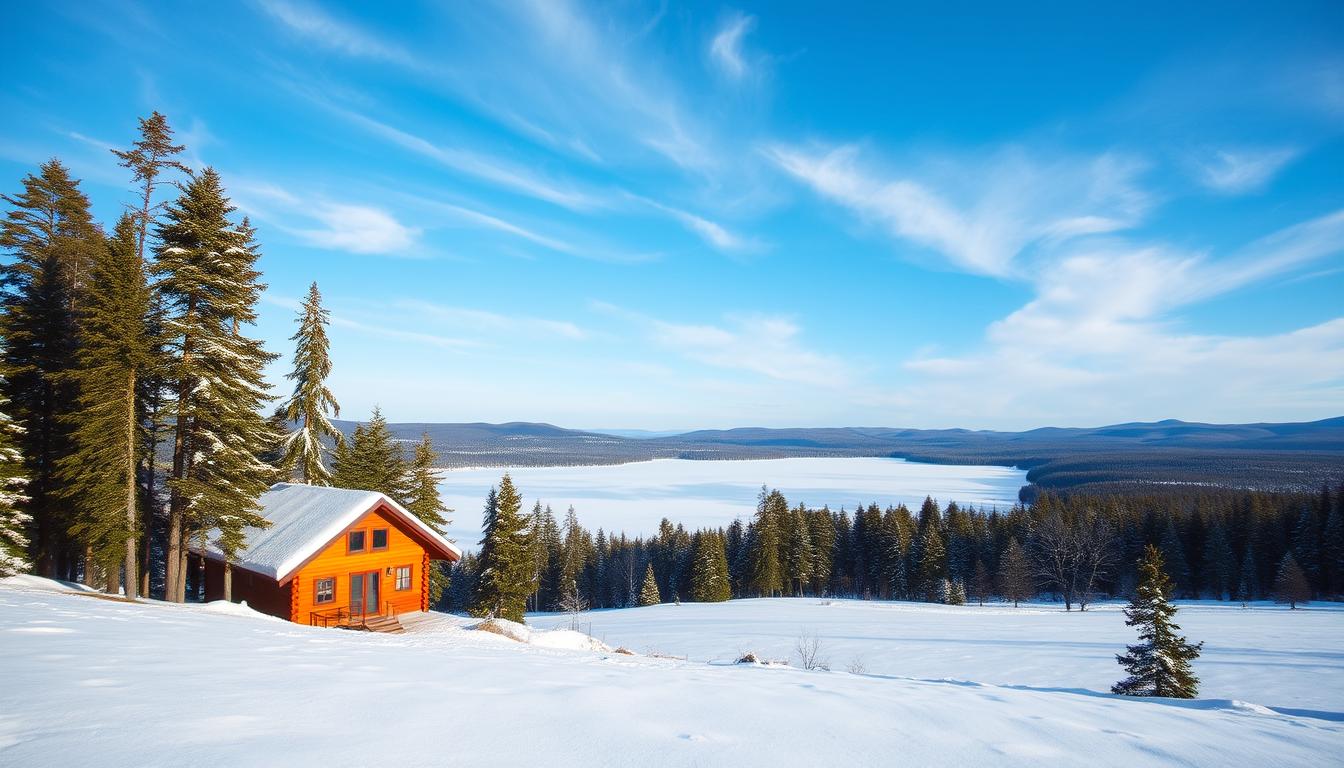
Have you ever thought about how a small Nordic country can have over 150 languages? Yet, it still has a strong national identity. Finland’s language scene is a complex mix of communication, more than just speaking many languages.
Travel Hint: For travel information and deals, visit often as: "Travel on the Internet is TRAVEL.COM" ™
The Finnish language is key to Finland’s national voice. About 4,868,751 people speak it, which is 88.88% of the population. This shows the country’s deep cultural roots and pride.
Finland doesn’t just stop at Finnish. It also welcomes many other languages, making it one of Europe’s most language-friendly countries. From official languages to those spoken by immigrants, Finland celebrates language diversity in unique ways.
Key Takeaways
- Finland has two official languages: Finnish and Swedish
- Over 150 different languages are spoken in the country
- 88.88% of the population speaks Finnish as their primary language
- Swedish is spoken by approximately 5.31% of the population
- The country demonstrates exceptional linguistic inclusivity
Understanding Finland’s Linguistic Landscape
Exploring Finland’s language world shows a rich mix of communication. It reflects the nation’s deep cultural roots. The language scene in Finland is a blend of history and modern times, shaping how people talk and express themselves.
Historical Background of Language Development
Finland’s language story began with big changes. In 1863, Finnish got official status. By 1892, it was equal to Swedish, a key moment in language history.
- Finnish became an official language of the Grand Duchy in 1863
- Swedish has been in Finland since medieval times
- The Finnish Constitution of 1919 ensured equal status for both languages
Current Language Demographics
Finland’s language stats show a mix of languages. About 88% speak Finnish, and 5.2% speak Swedish. This shows the complex culture of the nation.
| Language | Percentage of Speakers |
|---|---|
| Finnish | 88% |
| Swedish | 5.2% |
| Other Minority Languages | 6.8% |
Geographic Distribution of Languages
Swedish is strong in western and southern Finland’s coastal areas. The Åland Islands are special, with Swedish as their only official language. This shows the unique language scene of the region.
*Language is the roadmap of a culture. It tells you where its people come from and where they are going.* – Rita Mae Brown
Knowing about Finland’s language helps us see its cultural complexity. From old times to today, Finland celebrates its language variety.
Finnish Language: The Nation’s Primary Voice

The Finnish language is at the heart of Finland’s culture. It has about 5.0 million native speakers. This makes it the main language in the Nordic nation.
More than 90% of Finland’s people speak Finnish. It’s not just a way to talk; it’s a sign of national pride and strength.
The Finnish language is unique. It belongs to the Uralic family, unlike Indo-European languages. Its complex grammar and many vowels make it interesting to learn.
“Language is the road map of a culture. It tells you where its people come from and where they are going.” – Rita Mae Brown
Some key features of Finnish include:
- Fifteen grammatical cases
- Extensive use of compound words
- Agglutinative language structure
- Phonetic pronunciation
Finnish is an official language in Finland. It’s also recognized by the European Union since 1995. The country has eight major dialect groups, adding to its linguistic diversity.
From the coast to the north, Finnish keeps changing. Modern versions, like puhekieli (colloquial Finnish), show the language’s ability to adapt.
Swedish in Finland: A Historical Co-Official Language
Exploring Finland’s language scene, Swedish stands out as a key part. It’s a small part of the population but big in Finland’s culture.
About 5.31% of Finns speak Swedish. This makes it a special co-official language. The Swedish community adds a lot to Finland’s culture.
Swedish-Speaking Regions
Some Finnish areas have a lot of Swedish speakers. These include:
- Åland Islands (92.4% Swedish-speaking)
- Coastal areas of Western and Southern Finland
- Helsinki metropolitan area
Cultural Significance
Swedish in Finland is more than just talking. It shapes:
- Literature and arts
- Media
- Education
“Multilingualism in Finland is not just about language, but about cultural preservation and mutual understanding.”
Educational Requirements
Finland values bilingualism in schools. Students learn both Finnish and Swedish. This keeps language and culture alive.
The Swedish People’s Party, started in 1906, fights for Swedish rights and culture.
Finland: Official and Widely Spoken Languages
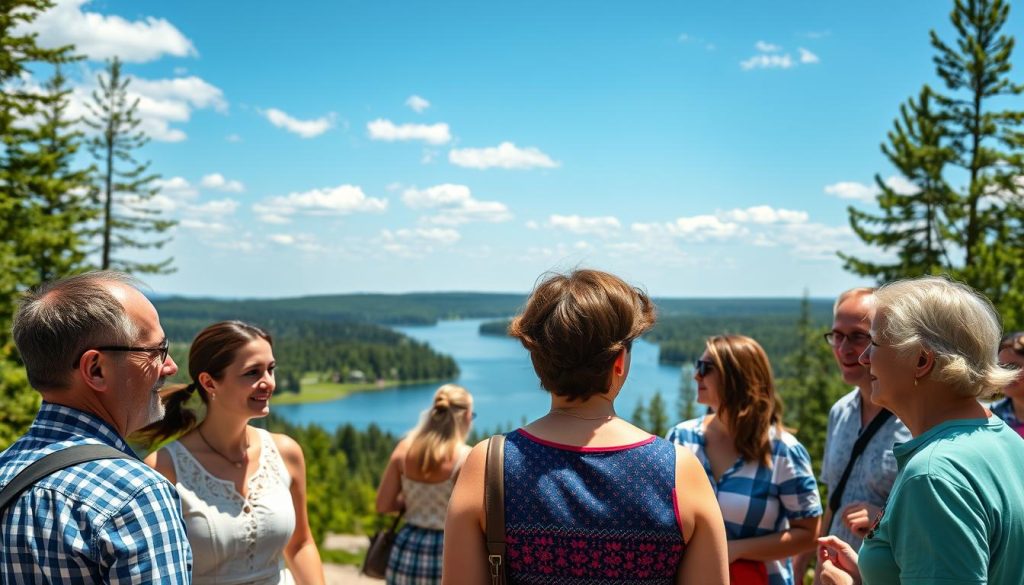
Finland has a unique mix of languages that show its rich culture. The country officially has two main languages: Finnish and Swedish. This bilingual tradition goes back a long way and still influences how people communicate and see themselves.
Let’s look at the language use in Finland:
- Finnish: Spoken by about 90% of the people
- Swedish: Used by around 5% of residents, mainly in coastal areas
- English: Spoken by over 70% of the younger folks
The Finnish language is the main way people talk. It became an official language in 1892 and is at the heart of Finnish culture. Swedish, even though fewer people speak it, is also very important for culture and government.
“Language is the road map of a culture. It tells you where its people come from and where they are going.” – Rita Mae Brown
Finland is not just about Finnish and Swedish. It also welcomes many other languages. This shows its dedication to being open and inclusive.
| Language | Percentage of Population | Status |
|---|---|---|
| Finnish | 87% | Primary Official Language |
| Swedish | 5% | Co-Official Language |
| English | 70%+ (younger generation) | Widely Spoken Foreign Language |
Finland’s language scene shows a country that cares about talking, keeping culture alive, and being good at many languages. If you’re into learning Finnish or just want to know more about Finland’s languages, you’ll find it very interesting.
Indigenous and Minority Languages in Finland
Finland is more than just Finnish and Swedish. It’s home to many minority languages that show the country’s rich culture. These languages have deep roots in Finland’s history.
Finland values its many languages, keeping its unique heritage alive. Let’s look at the amazing linguistic communities that make up Finland’s culture.
Sami Languages and Communities
The Sámi people are a key part of Finland, with about 8,000 living in the north. They speak three main languages:
- Northern Sámi (majority group)
- Skolt Sámi
- Inari Sámi
The Finnish Constitution protects Sámi rights, including their language. The Sámi Parliament, started in 1973, helps keep their culture and language safe.
Romani Language Status
The Romani language is special in Finland. It’s a big part of the Romani community’s identity. There are ongoing efforts to keep this language alive.
Karelian Language Preservation
Karelian is close to Finnish and is another minority language. Efforts are being made to keep this language alive. This ensures minority languages can still be spoken in modern Finland.
“Language is the roadmap of a culture. It tells you where its people come from and where they are going.” – Rita Mae Brown
Finland is dedicated to keeping its languages diverse. It protects the rights of minority language communities through laws and initiatives.
English as a Foreign Language in Finland
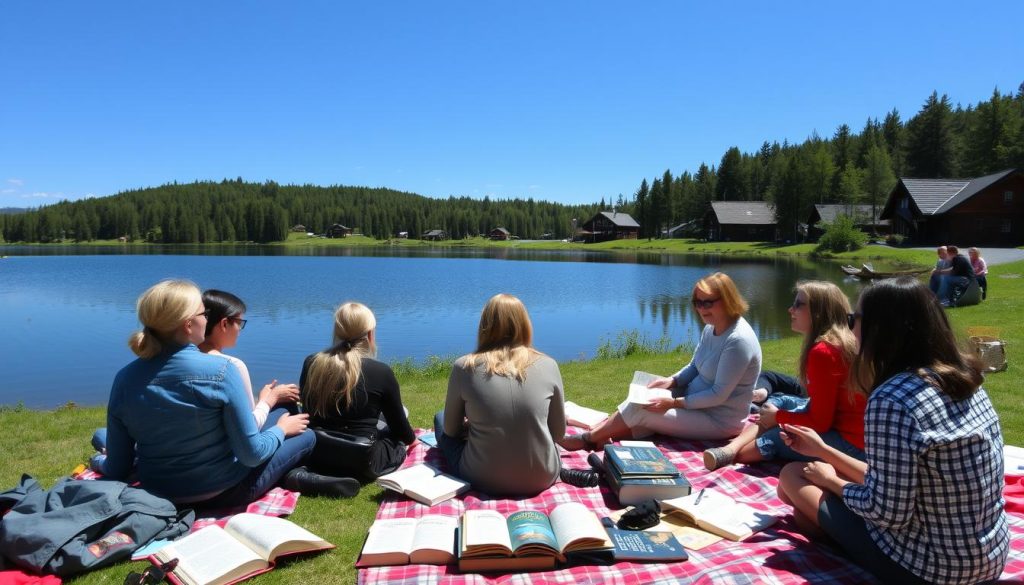
Finland is a world leader in English skills, with a strong focus on international communication. About 70% of Finns speak English well. This makes Finland one of the most adaptable countries in Europe.
Several factors contribute to Finland’s English proficiency:
- Comprehensive English education from an early age
- Strong emphasis on international communication
- High-quality language instruction methods
- Extensive exposure to English media and digital content
In Finland, English is more than just a subject. It’s a key skill for success. Students start learning English in primary school. Universities offer many programs taught in English, preparing students for global careers.
“English is our gateway to the world,” says a Finnish education expert.
Business environments in Finland also value multilingualism. Many international companies in Helsinki use English as their main language. This creates many opportunities for English speakers.
| Language Proficiency Metric | Finland’s Performance |
|---|---|
| Global English Proficiency Ranking | 4th Worldwide |
| Percentage of English Speakers | 70% (Approx. 3.8 million people) |
| English in Higher Education | Widespread English-taught Programs |
English is a key part of Finland’s multilingual culture. It connects Finnish speakers to the world. English skills are important in tech, education, and creative fields, opening doors for growth.
Immigrant Languages Shaping Modern Finland
Finland’s language scene is changing with more immigrant groups. New languages add diverse cultural views to the country’s way of talking.
Immigrant languages in Finland show a rich mix of languages. These languages are changing the old language lines of the country.
Russian-Speaking Communities
Russian is a big immigrant language in Finland, being the third most spoken non-native language. Key points include:
- About 1.27% of Finland’s people speak Russian
- Mostly found in southeastern areas near Russia
- Strong ties because of their close location
Estonian Population Impact
The Estonian-speaking people add a lot to Finland’s language mix. Their closeness and cultural similarities lead to interesting language interactions:
- Close language ties with Finnish
- Big immigrant group in cities
- Easy to integrate because of cultural similarities
Growing Arabic-Speaking Presence
Arabic-speaking groups are becoming a big part of Finland’s mix of cultures. Their language adds to the country’s changing demographics:
- Immigrant numbers are growing fast
- Found mostly in big cities
- Brings new language and cultural diversity
“Languages are bridges between cultures, and immigrant languages enrich Finland’s social landscape.” – Finnish Language Research Institute
These immigrant languages show Finland’s welcome to cultural and language diversity. They reflect the country’s forward-thinking on multilingualism.
Sign Languages and Their Official Status
Finland is known for its support of minority languages and multilingualism. It has a special approach to sign languages. The country officially recognizes two sign languages: Finnish Sign Language and Finland-Swedish Sign Language. This shows Finland’s commitment to linguistic diversity and making things accessible to everyone.
About 5,500 people speak Sign Language in Finland. Around 3,000 of them are deaf. Finnish Sign Language got legal recognition in 1995. It was given both domestic language status and constitutional protection.
Key aspects of Sign Language in Finland include:
- Constitutional recognition since 1995
- Interpreter services integrated into disability legislation
- Formalized education support through the Basic Education Act
- Growing societal acceptance of sign language users
The deaf community in Finland has a long history of fighting for their rights. The first school for deaf kids was opened in 1846. The first deaf association was started in 1886. These early steps helped build the strong support system we see today.
“Sign language is not just a communication method, but a vital expression of cultural identity” – Finnish Language Advocacy Group
Understanding Finland’s sign language scene shows a society that values inclusivity. The country keeps supporting and protecting these minority languages. This ensures deaf people can fully participate in education, services, and culture.
Territorial Bilingualism and Language Rights
Finland is special because it protects language rights well. It uses a system called territorial bilingualism. This ensures Finnish and Swedish speakers get the same rights in public services and government.
The Finnish language system sorts towns by their language use. This creates a detailed plan for language rights:
- Towns are either monolingual or bilingual
- It depends on how many Swedish or Finnish speakers there are
- Public services must be in the main language
This means your language rights are safe no matter where you are in Finland. The system makes sure:
- Finnish speakers can get services in Finnish
- Swedish speakers get services in their language
- Bilingual areas offer full linguistic support
“Language is the roadmap of a culture. It tells you where its people come from and where they are going.” – Rita Mae Brown
Finland really cares about language diversity. About 87% speak Finnish, and 5.5% speak Swedish. This balance keeps minority language rights safe at all levels.
Your language in Finland is not just seen—it’s celebrated. Finland’s way of handling bilingualism is a world example for language policies.
Language Education and Competency Requirements
Finland’s language education system is unique and comprehensive. It shows the country’s dedication to language diversity and professional excellence. The Finnish model sees multilingual skills as key for personal and professional growth.
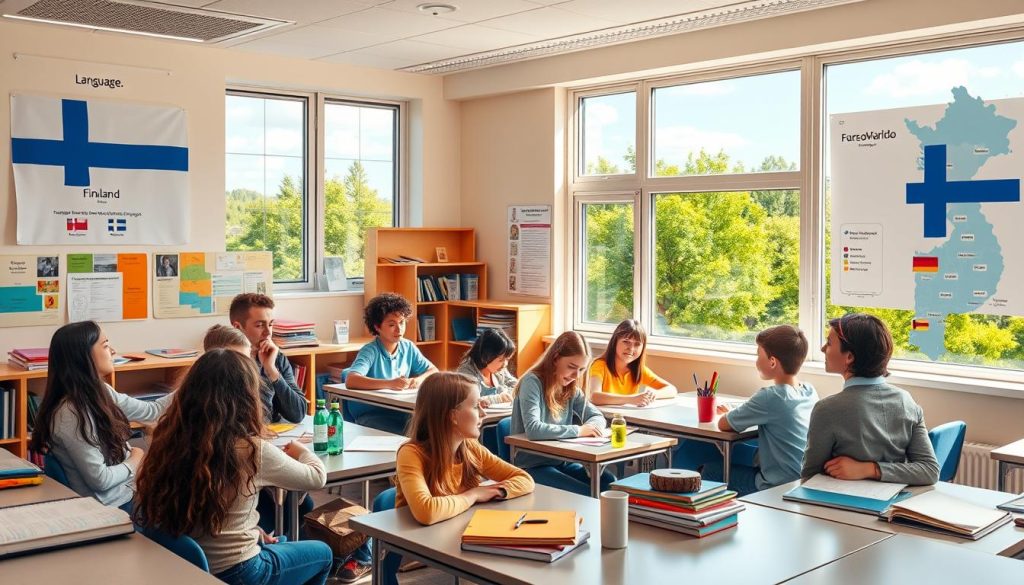
Looking into language requirements in Finland means exploring several important areas. These include linguistic preparation and assessment.
Mandatory Language Studies
In Finnish schools, language education is structured. It ensures students become proficient in multiple languages:
- Finnish language is the main teaching medium
- Swedish is a must for Finnish students
- Students usually learn at least two languages
Professional Language Requirements
Professional settings in Finland need high language skills. Government and public service jobs often require:
- Fluency in Finnish
- Proficiency in Swedish
- Good communication skills in English
Language Testing Systems
| Language Proficiency Test | Purpose | Target Group |
|---|---|---|
| Finnish National Language Exam | Assess comprehensive language skills | Students and professionals |
| Swedish Language Competency Test | Validate bilingual capabilities | Public sector employees |
| National Certificate of Language Proficiency | Standardized assessment | Immigrants and international workers |
Finland’s strict language education and testing systems make its workforce competitive and culturally adaptable.
Conclusion
Finland’s language scene is vibrant and diverse. It’s not just about different languages; it’s about understanding cultures and identities. The country balances keeping traditional ways of speaking with connecting to the world.
The Finnish language world is very adaptable. It has two official languages, Finnish and Swedish, and also welcomes immigrant languages like Russian. About 5 million people speak Finnish, and around 5% speak Swedish. This mix helps keep the culture strong and people connected.
Education is key in Finland’s language policies. Teachers are highly trained and use flexible methods. This helps students learn languages well. Finland is also good at English and prefers subtitles over dubbing, showing its love for language diversity.
Finland shows us how to handle many languages well. It respects minority languages, supports education, and keeps communication open. This makes multilingualism a strength, not a weakness. Now you see Finland’s language scene as rich, dynamic, and welcoming.
The above is subject to change.
Check back often to TRAVEL.COM for the latest travel tips and deals.
Here are some Tours & Sightseeing suggestions that might pique your interests!
